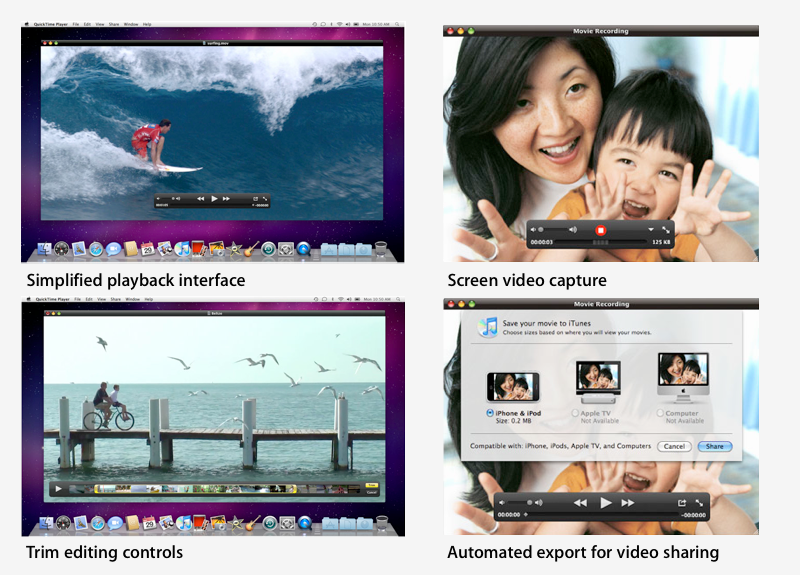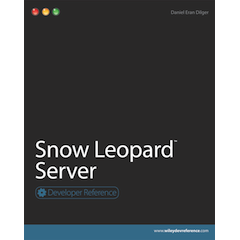Inside Mac OS X Snow Leopard: QuickTime X
Meet QuickTime X
It is commonly reported that Snow Leopard's new QuickTime X (that's X for ten, not "ex") shows full screen movies without the Pro upgrade nag and allows for screen video captures and uploads to YouTube. Yes, those features are nice, but only the tip of the iceberg.
Essentially, Apple has pulled an iMovie 08 here: rather than enhancing features of the current QuickTime 7.x, Apple has replaced it entirely with a new version written from the ground up to create a launching pad for a new generation of media-related development. Snow Leopard's QuickTime X is actually derived from work done to build the iPhone's mobile optimized, embedded QuickTime playback software.
Also like iMovie 08, the new QuickTime X doesn't do everything that the previous QuickTime 7.x does, such as providing complex transcoding options, component plugins for installing alternative codecs, or the ability to hint tracks for RTSP streaming via QuickTime Streaming Server. That's why Apple includes an updated version of the previous QuickTime 7.x player as an optional install in Snow Leopard to handle all of those features.
What QuickTime X does do is add more features that people will actually use regularly, things like automated transcoding and export for sharing content to MobileMe, YouTube, and iTunes as well as full screen and panoramic movie playback, simple trim editing controls, ColorSync support, and screen capture video recording. All with no nagging to buy a Pro version upgrade.
HTTP Live Streaming
But the real potential for QuickTime X relates to HTTP Live Streaming, a new open protocol for dishing out live or on-demand video streams using standard web requests.
If streaming playback were only limited to QuickTime X in Snow Leopard, this might not be that big of a deal, but Apple has lined up support from content delivery networks and already added HTTP Live Streaming to iPhone 3.0.
That means there are already over 45 million mobile clients optimized to view HTTP Live Streaming videos; that installed base also happens to consume a plurality of the world's mobile web traffic. Add in new QuickTime X clients on the desktop and Apple has a ready-made dominant standing in mobile video streaming.
Apple TV 3.0
What about Apple TV 3.0? There could be more information on that in the coming iPod event on September 9, but it's safe to say that Apple TV will eventually also offer HTTP Live Streaming on it, too. This will make the device much more "TV like," in that it will be able to peruse streaming video feeds without requiring an initial progressive download.
Having a cheap, flexible and open protocol for delivering video to millions of iPhone, iPod touch, QuickTime, and Apple TV viewers will democratize live and on-demand video publishing just like podcasting has, enabling anyone to set up live feeds of events without needing a specialized RTSP streaming server.
Having a cheap playback appliance that makes it easy to view these feeds on your TV should definitely help Apple TV gain traction, particularly once Apple lowers its price again. But HTTP Live Streaming will also benefit PC users in general, including Linux users as the new protocol is entirely based on open standards and can be implemented using open software. That will help erase the efforts to force video content into proprietary formats like WMV that only work on Windows.
The QuickTime X Foundation
Snow Leopard's new QuickTime X dusts off the company's now nearly twenty year old QuickTime technology portfolio and implements Mac OS X's media capabilities using new code that is both fluent in 64-bit Cocoa as well as GPU-savvy on the latest generation Macs using NVIDIA's 9400M.
In the future, Apple will flesh out QuickTime X to incorporate editing and plugin features currently only available in the previous 7.x version, much as the company incrementally transitioned from 68k or PowerPC chips, or from the classic Mac OS to Mac OS X, or from Carbon to Cocoa, each time using a temporary bridge. This transition will also impact Apple's Final Cut Studio suite, which is currently tied to the old QuickTime, Carbon, and 32-bit code.
Apple's QuickTime role is therefore more than just as a platform developer; it's also a major client application developer. This will force the company to make QuickTime X a practical, developer-friendly, and capable technology in contrast to the complex and arcane PowerTalk and QuickDraw GX it tried to foist upon developers back in the early 90s.
Up next: everybody knows Snow Leopard delivers new 64-bit features, but what's new about 64-bits, why does it matter, which Macs will benefit, and where does that take the Mac platform in the future? Inside Mac OS X Snow Leopard: 64-bits will examine.
Daniel Eran Dilger is the author of "Snow Leopard Server (Developer Reference)," a new book from Wiley available now for pre-order at a special price from Amazon.
 Daniel Eran Dilger
Daniel Eran Dilger












 Malcolm Owen
Malcolm Owen
 William Gallagher
William Gallagher
 Christine McKee
Christine McKee
 Michael Stroup
Michael Stroup
 William Gallagher and Mike Wuerthele
William Gallagher and Mike Wuerthele


 Chip Loder
Chip Loder







